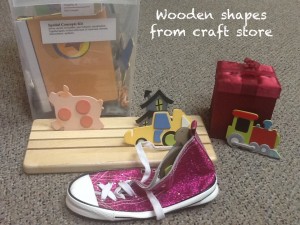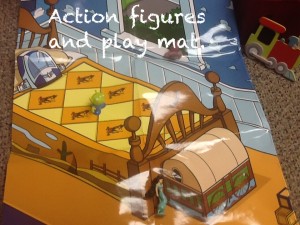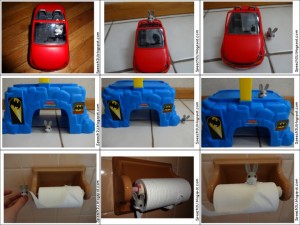Last year I scored big at Goodwill when I found a barely used Flamingo Bingo from Super Duper Publications for 1.99!! What a great deal.
Spatial concepts can be difficult to teach children. I think they are probably more difficult for children with motor planning problems or sensory integration dysfunction. It’s that connection between language and praxis again. Does language affect your ability to move and interact with objects within your environment?
The good thing is that Spatial Concepts can be really fun to teach. I find that I like to teach spatial concepts using:
- Real Objects
- Gross Motor Activities
- Custom Photo Cards
Real Objects
Because I like my world labeled and stored inside of a rubbermaid container, I made a Spatial Concepts box.
It contains:
- small action figures from popular movies (Star Wars, Toy Story, Avengers)
- Base from a Cookbook holder I received for Christmas one year to work on concepts such as next to, behind, in front, and right/left.
- A variety of containers to work on in/on/under. I have present boxes, and the sparkly shoe is a pencil case I got at Target this fall. I like things that would be kind of silly-like a small plastic toilet-(which seriously, you should send to me if you have one.) Silly is motivating for my clients.
Gross Motor Activities
If you have access to a gym at your classroom or clinic, use it! This is a great opportunity to work on where the clients body is in space. One activity that can be really fun is to write the preposition word that you want to target on a piece of Paper. Make it a big card because big seems exciting.
Then have or help your client show you 5 things they can get “in.”
Custom Photo Cards
I see a lot of products on Teachers Pay Teachers which use character likenesses (Star Wars or Harry Potter cards) to illustrate their products. I love using special interests in therapy, BUT I’m fairly certain that this is a violation of copyright in regards to character licensing. Sometimes (especially when working with students on the Autism Spectrum) it is really helpful to incorporate their special interest within the therapy session. You can use the actual objects or action figures but if you need to work on receptive identification or just want to practice the sentences at the word level are you out of luck?
In these cases, I will make up a set of Custom Photo Cards. I choose the action figure that I want and then set up some scenarios that illustrate the concept I am trying to teach. I try to pick some that will be “hilarious” so that we can work on joint attention and sharing our emotions. Here are some cards I made up for Easter-although you could use them any time. I like that you can target small changes in sentences by working with these as strips. For example:
- The bunny is IN the car
- The bunny is ON the car
- The bunny is NEXT TO the car.
Because you have the materials, you could work on visualization too:
Place the 2 objects in front of the child. “I want you to picture the bunny is in the car.” Then have them put the bunny in the car. Ask them, did it match up with the picture they made in their mind.






